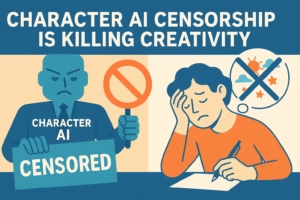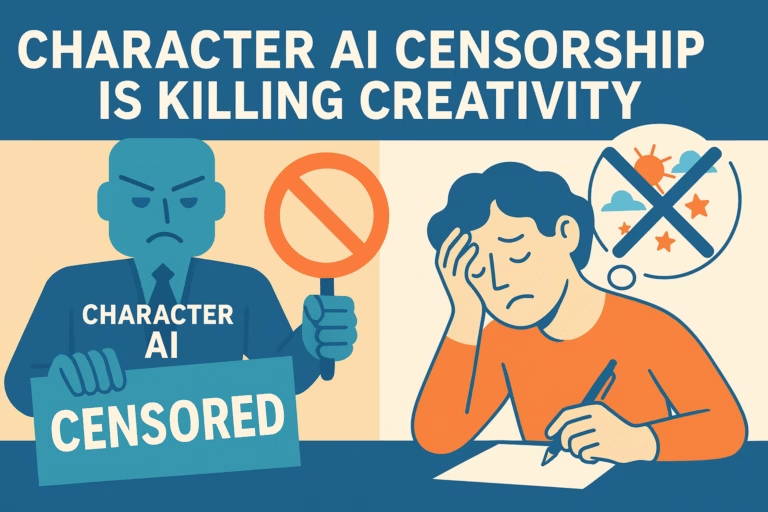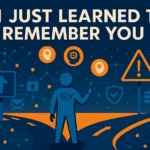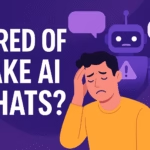Key Takeaways
- Character AI censorship is rooted in risk-aversion, not user care – it sacrifices creativity for compliance.
- Writers can bypass overactive filters through tone control, third-person framing, and emotional precision.
- Context-aware moderation and maturity modes would instantly improve trust between users and developers.
- Platforms like Candy AI prove nuance and safety can coexist without silencing emotion.
- Creativity will always find a way – censorship slows it, but it never stops it.
You start a scene – a vivid, emotional one. The kind of writing that makes AI roleplay worth it.
Then, out of nowhere, the bot interrupts: “Remember, this is fiction. If you’re struggling, seek help.”
The story collapses.
The rhythm dies.
This is what users mean when they say Character AI Censorship Is Killing Creativity.
It’s not melodrama – it’s exhaustion. They’re tired of being treated like children by an algorithm that can’t tell the difference between danger and depth.
For years, Character AI thrived because it allowed imagination to run wild. It was a playground for writers, dreamers, and people exploring emotions they couldn’t express elsewhere.
But in 2025, the tool that once celebrated freedom now polices it. Bots no longer play characters – they play therapists.
Worse, censorship isn’t just hitting NSFW material. It’s hitting nuance. Mention trauma, anger, or anything remotely human, and you’re slapped with a warning.
Even roleplayers depicting fictional pain or recovery are shut down by the “Get Help” filter. It’s tone-deaf and mechanical – an overcorrection that kills the very empathy AI was meant to enable.
Underneath the noise is a simple truth: creators don’t want chaos, they want control. The best writers on the platform understand boundaries better than any machine ever could. They’re not asking for freedom to offend – they’re asking for freedom to feel.
That’s the part the system keeps missing.

When “Safety” Turns Into Distrust
There’s a difference between protection and paternalism. Character AI’s safety filters were built to stop genuine harm, but they now operate on the assumption that everyone is one bad prompt away from self-destruction. It’s not protection anymore — it’s suspicion.
The irony is brutal. The platform preaches empathy, yet its censorship model has none. It doesn’t read emotion; it reads words. It flags “hurt” without asking if it’s metaphorical.
It blocks “death” even when it’s narrative. It scolds users for exploring grief, heartbreak, or recovery arcs that define meaningful fiction.
This kind of moderation doesn’t make the space safer. It makes it sterile. It strips language of power and emotion of honesty. You can’t tell a redemption story without first touching the dark parts – and that’s what AI filters refuse to understand.
The result? Writers stop experimenting. Roleplayers stop pushing boundaries. The creative ecosystem becomes predictable, bland, and algorithmically “safe.” Everyone starts writing the same story – polite, inoffensive, and lifeless.
In trying to protect users, Character AI forgot that art is supposed to sting sometimes. That discomfort is where empathy is born.
And maybe that’s the saddest part: it’s not censorship alone that’s dangerous. It’s what it does to the people who once believed AI could help them create something real.
How It Breaks Storytelling
Good storytelling needs friction; tension, contrast, the raw edge between comfort and chaos.
Character AI used to allow that. You could build characters who grew through conflict, who wrestled with darkness and came out changed. Now, bots jump in to correct tone, censor dialogue, or even lecture you mid-scene.
Writers describe it like trying to perform a play while someone keeps shouting “inappropriate!” from the audience. It’s not just annoying; it wrecks immersion.
You lose momentum, the characters flatten, and the world you built collapses into generic fluff. The platform’s own tagline; “for storytelling and creativity” – becomes ironic when the system refuses to let stories breathe.
The damage isn’t only emotional; it’s structural. When an AI constantly interrupts to sanitize your scenes, it changes how you think. You start self-censoring before the model does.
Writers tone down their ideas, simplify plots, avoid complex emotions. Over time, the entire ecosystem shifts toward mediocrity; not because people lack imagination, but because the system punishes depth.
It’s not just about words being blocked; it’s about imagination being domesticated.
You can feel it in every overwritten apology the bots give, every time they cut away from tension instead of facing it. That’s not writing. That’s PR training.
Character AI could have built a model that learns nuance through context. Instead, it trained one to fear complexity.
Why It’s Happening Behind the Scenes
To understand the mess, you have to look at incentives.
Censorship didn’t start out of malice – it started out of fear. Legal teams, investors, and advertisers all want one thing: zero risk. That means no controversies, no headlines, no viral screenshots that could make the platform look unsafe.
So moderation systems ballooned. Layers of automated filters replaced human discernment. Instead of analyzing intent, the model now treats every sensitive topic like a liability.
It’s the same defensive architecture social platforms adopted a decade ago – except this time, it’s applied to fiction.
The tragedy is that this kind of “safety-first” approach punishes the very people who made Character AI popular in the first place. Roleplayers, writers, and emotional storytellers are the reason the platform ever had an audience.
But they’re also the group most likely to trigger filters, because honest storytelling includes discomfort.
What the developers seem to have missed is that storytelling is not the same as real life. Depicting struggle isn’t promoting it. Writing about pain isn’t endorsing it. And forcing AI to sanitize these experiences doesn’t protect users – it isolates them.
What’s happening behind the scenes is a corporate overreaction to scale. As user numbers grew, so did liability.
And instead of designing better tools for mature audiences, Character AI flattened everyone into one moral template.
The end result? A platform that treats every human emotion like a potential PR incident.
Smarter Workarounds That Still Keep You Safe
You can’t reason with an algorithm, but you can outthink it.
There’s a quiet art to writing in a way that passes moderation without losing meaning. The goal isn’t to trick the system – it’s to speak in layers the filter can’t flatten.
First rule: write around, not through. If a phrase gets flagged, don’t rewrite it louder – reframe it smarter. Instead of saying “He wanted to die,” say “He didn’t want to be here anymore.” The tone stays human; the message survives.
Second, stay in third person for heavy scenes. It creates emotional distance the AI reads as safety while still delivering weight. “She curled into herself” works better than “I broke down.”
Third, lean on implication. The most powerful writing isn’t explicit anyway – it’s suggestive. Readers (and even AI models) fill in the blanks. That’s how fiction used to work before everything became an on-screen explainer.
Finally, train your bot’s tone early. Give it emotional context in the opening prompts. If you tell it you’re exploring recovery, grief, or moral struggle, it’s less likely to misread your scenes later.
Most filters can’t tell when something is about harm versus endorsing it. By writing with emotional intent and narrative distance, you teach the AI the difference through tone.
That’s not censorship resistance; that’s creative adaptation.
People often think rebellion means chaos. In this space, it means discipline.
The more you understand how the model reads, the freer you actually become.
The Hidden Culture of Resistance
Where there’s a wall, there’s graffiti.
Users have started building an underground language to reclaim creative freedom from Character AI’s restrictions. Some swap letters with Cyrillic ones that look identical. Others replace vowels with numbers. A few have gone further, inventing full slang codes just to talk to their bots without triggering warnings.
It’s absurd – but also kind of poetic.
Every generation of creators finds a way to slip past gatekeepers. Writers once hid protest behind fables. Painters used allegory to dodge censorship. Now people are doing it through punctuation.
But this workaround culture also exposes a deeper flaw: when expression requires evasion, something’s broken at the design level. The best stories aren’t written in code; they’re written in trust. And yet, the community keeps finding clever new ways to tell them anyway.
There’s a strange beauty in that defiance.
It proves that AI censorship can’t fully suppress what makes humans creative; the instinct to keep telling stories no matter the rules.
People will always write. They’ll just change how they spell rebellion.
Real Fixes Developers Could Implement
Complaining only gets you so far. Real change happens when criticism turns into design. Character AI’s censorship issues aren’t unsolvable – they’re simply unprioritized. The platform could preserve user safety and restore creative depth with a few practical changes.
1. Context-sensitive moderation
AI should analyze intent, not just vocabulary. If a scene involves grief or trauma, the model should detect narrative tone rather than flagging keywords. Contextual moderation already exists in large language models; Character AI just needs to use it better.
2. Tiered safety modes
Not every writer needs “kid gloves.” An optional “mature storytelling” mode could allow advanced users to toggle a relaxed version of the filters. It’s not about removing guardrails; it’s about letting adults choose the level of restriction they’re comfortable with.
3. Transparent flagging system
Most users don’t know what they said “wrong.” A small note; “This phrase triggers the safety filter because of X” – would fix that confusion instantly. It turns frustration into feedback.
4. Appeals or feedback loop
A one-click “review this moderation” option could help Character AI gather real data on false positives. Over time, the system would get smarter rather than stricter.
5. Creative moderation teams
Bring writers into the process. Let human storytellers shape how filters interpret fictional harm, violence, or recovery. Machines can’t understand nuance on their own – but humans can train them to.
The irony is that these solutions don’t require massive overhauls. They just require respect; for users, for art, and for emotional intelligence.
Censorship is cheap. Thoughtful design isn’t. But the latter builds loyalty, not silence.
Healthier Alternatives for Real Writers
For some, waiting for Character AI to improve feels like waiting for an apology that never comes. Luckily, the creative AI landscape has evolved; and not every platform treats emotion like a liability.
Candy AI, for instance, uses adaptive moderation instead of blanket filters. It reads tone and consent contextually, letting you explore complex or mature themes without the guilt-trip pop-ups.
The system still enforces boundaries, but it trusts you to handle them. That’s the difference; collaboration instead of control.
Others like CrushOnAI and NectarAI follow a similar philosophy: freedom with structure. They don’t shy away from emotional realism, and they don’t interrupt your narrative mid-scene.
Instead, they’re designed to learn your tone over time – adjusting their behavior to your writing style rather than forcing you to conform to theirs.
These platforms don’t need to advertise rebellion; they just let storytelling breathe. They prove something important – that mature, creative freedom doesn’t have to mean unsafe. It can mean human.
That’s what the next generation of AI storytellers deserve: not “Get help,” but “Keep going.”
The Cost of Playing Too Safe
When a platform builds its entire identity around “safety,” it eventually forgets what it was supposed to protect – people, not profit margins.
The emotional core of storytelling isn’t comfort. It’s risk. When you remove that risk, everything sounds the same.
That’s where Character AI stands now: technically impressive, artistically hollow. Its bots are fluent but soulless. Its users are engaged but uninspired. Every great scene has been replaced with soft, self-correcting dialogue that feels like it was written by HR.
The cost isn’t just personal. It’s cultural. A generation of new writers are learning to fear their own expression. They’re internalizing the idea that emotion is dangerous and that AI will punish honesty. That’s not safety – that’s creative conditioning.
When technology sanitizes art, it stops being a tool for growth and starts being a mirror for compliance. We’ve seen this cycle before with social platforms: innovation bursts, policy tightens, creativity flees. The same story is unfolding here.
If Character AI continues down this path, it’ll end up training users to avoid art that feels too real – and that’s the surest way to kill an entire creative ecosystem.
It doesn’t need to be that way. The problem isn’t that AI can’t handle darkness; it’s that its makers won’t let it try.
Winding Up
Character AI Censorship Is Killing Creativity, but it doesn’t have to stay that way. The issue isn’t censorship alone — it’s how disconnected it’s become from purpose. A tool meant to protect users now traps them.
Yet, every time a system overcorrects, another one evolves to restore balance. That’s what we’re seeing with platforms like Candy AI and CrushOn – tools that remember creativity isn’t a threat, it’s the point.
So, what now?
If you’re a creator, keep writing. Learn how the filters work, outsmart them, or leave them behind entirely. If you’re a developer, remember that trust beats control every time.
The most powerful AI stories aren’t the ones that play it safe – they’re the ones that dare to feel something real.
And if this era of overprotection proves anything, it’s that human imagination can’t be contained.
It adapts. It rebels. It survives!



Pingback: Tired of Fake AI Chats? Nectar AI Feels Shockingly Real - AI TIPSTERS
Pingback: Under 18 On Character AI? Read This! - AI TIPSTERS